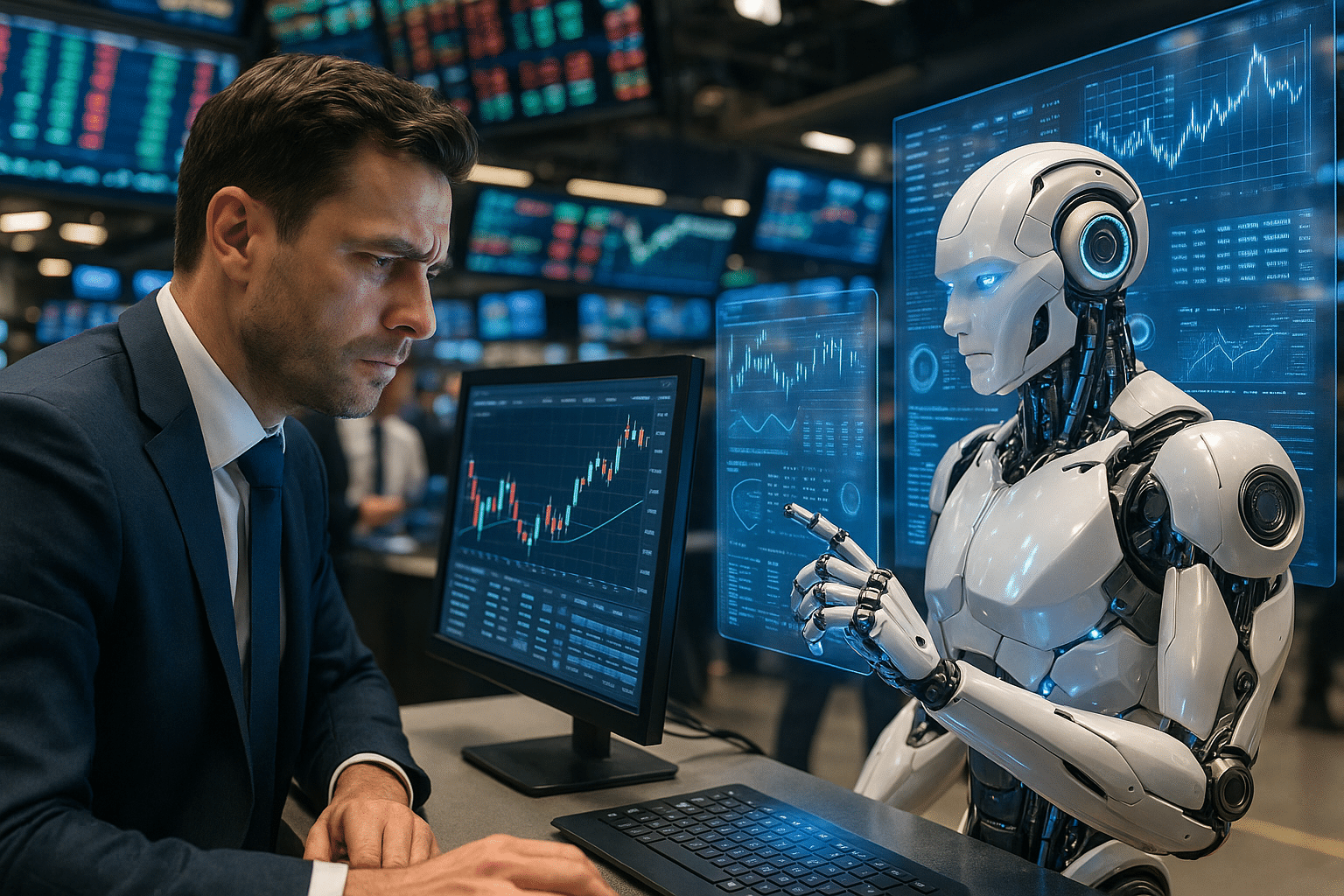As the wheels of technology turn, the global financial markets continually transform, sparking an age-old debate into a raging inferno: Who will prevail in the high-stakes arena of market dominance — Artificial Intelligence (AI) or human traders? This article aims to delve deep into this pressing question, examining the strengths, weaknesses, and ultimately, the future roles of AI and human traders in the financial markets.
Investing and trading have always been seen as the preserve of highly skilled individuals who use their knowledge, experience, and intuition to navigate the volatile and often unfathomable waters of the financial markets. But with the advent of AI technology, this dynamic is dramatically shifting. 🤖
AI, with its ability to process large amounts of data at lightning speed, make complex calculations, and learn from its own mistakes, has begun to challenge the dominance of human traders. This has led to a fierce debate: Can AI outperform humans in trading?
Delving into the Capabilities of AI
The main strength of AI lies in its ability to process vast amounts of information at an incomprehensible speed. This not only allows it to make quick and informed decisions, but it also provides it with the ability to predict future market trends based on historical data. Can the human mind compete with such processing power and predictive ability? 🧠
AI is also immune to the emotional stresses that often lead human traders to make impulsive decisions. This emotional detachment allows AI to make trading decisions based purely on data and logical analysis, potentially leading to more consistent and profitable results.
Appreciating the Strengths of Human Traders
Despite the impressive capabilities of AI, human traders have a few unique strengths of their own. For one, they have the ability to think outside the box, a skill that’s crucial in the unpredictable world of financial markets. This allows them to make intuitive leaps and decisions that may not be possible for an AI.
Humans also have the advantage when it comes to understanding and interpreting news and social media sentiment. While AI can analyze these sources for data trends, it lacks the ability to understand the subtleties and nuances of human language and emotion. 😌
The question then becomes: Can the analytical prowess and speed of AI overcome the creativity, intuition, and emotional understanding of human traders? This is the question we aim to answer in this article.
We will delve into the unique advantages and disadvantages of both AI and human traders. We will explore how the increasing use of AI in trading is changing the dynamics of the financial markets. We will also discuss what the future might hold for both AI and human traders in the battle for market dominance. 🏦
As we venture into this fascinating topic, we invite you to keep an open mind, challenge your preconceived notions, and join us in exploring the future of trading. So, whether you’re an experienced trader, a tech enthusiast, or simply curious about the future of finance, buckle up for an enlightening journey. 🚀
Ready? Let’s dive in.
🤖 The Rise of Artificial Intelligence in Trading
As we venture further into the digital age, the rise of artificial intelligence (AI) in the trading world has become increasingly apparent. The capability of AI to process and analyze vast amounts of data within a fraction of a second makes it a potentially invaluable tool for traders. Utilizing machine learning, AI can identify patterns and trends that human traders might miss, providing a competitive edge in the fast-paced, high-stakes world of trading. Notably, this is the case in high-frequency trading, where algorithms are used to make thousands of trades per second. Watch “Artificial Intelligence: The Future of Stock Trading?” by ColdFusion to understand more about this emerging trend.
However, the incorporation of AI into trading is not without its challenges. The intricate and unpredictable nature of the financial markets means that even the most sophisticated AI systems can make errors. Furthermore, while AI can undoubtedly process information faster than a human trader, it lacks the instinct, intuition, and emotional intelligence that human traders bring to the table. So, the question arises: will AI ultimately dominate the trading world, or will human traders maintain their foothold?
Before diving into the nitty-gritty of this debate, it’s crucial to comprehend the fundamentals of both AI and human trading. This understanding will help us better appreciate the comparative strengths and weaknesses of both parties in the trading arena.
🧠 Understanding Human Trading
Human trading has been at the heart of the financial markets for centuries. Despite the technological advances in the field, many traders still prefer to rely on their expertise, intuition, and emotional intelligence. This reliance on ‘gut instinct’ often comes from years of experience and a deep understanding of the markets, which some argue cannot be replicated by a machine.
Human traders also have the advantage of being able to interpret news and world events, understanding their potential impact on the markets. While AI systems can be programmed to analyze news to some extent, they may struggle to grasp the full implications of complex geopolitical events. Watch “Human vs Robot Trading” by Top Traders to gain insight into how human traders use their skills and intuition in the trading world.
Nonetheless, human traders are not without their limitations. The capacity to process and analyze data is restricted by human cognitive abilities. Furthermore, emotional responses can sometimes lead to irrational trading decisions, a problem not encountered by emotionless AI systems.
🤖📈 AI Trading: What Does it Entail?
AI trading, also known as algorithmic trading, involves using computer programs to execute trades based on pre-determined criteria. These systems can process vast amounts of data, identify trends and patterns, and execute trades much faster than any human could. The primary advantage of AI trading is its ability to make objective decisions based on data, without any emotional interference.
In recent years, AI systems have become increasingly sophisticated, with many utilizing machine learning to adapt to changing market conditions. These AI systems can be trained to recognize complex patterns and make predictions based on historical data. Watch “AI Trading: The Future of Finance?” by Wall Street Mojo to learn more about how AI is transforming the trading landscape.
Despite these advantages, AI trading also has its shortcomings. For instance, while AI can analyze data at unprecedented speeds, it may struggle to interpret complex news events accurately. Additionally, AI systems are only as good as the data they are trained on, meaning they can make errors if the training data is flawed or incomplete.
🥊 AI vs Human Traders: The Showdown
| AI Traders | Human Traders |
|---|---|
| Can process and analyze vast amounts of data rapidly | Ability to interpret complex news and world events |
| Objective decision-making without emotional interference | Use of intuition and ‘gut instinct’ based on years of experience |
| Potential for errors if training data is flawed or incomplete | Limited by human cognitive abilities and potential for emotional responses |
In conclusion, both AI and human traders have their distinct advantages and limitations. While AI can process information rapidly and make objective decisions, it lacks the ability to interpret complex world events and the intuition that comes from experience. On the other hand, human traders bring a wealth of experience and emotional intelligence to the table, but they are limited by their cognitive abilities and potential for emotional responses. As such, the future of trading may well involve a blend of AI and human input, combining the strengths of both to achieve the best possible outcomes.
To explore this showdown further, check out “AI vs. Human Trading: Who Wins?” by The Trading Channel. As we progress into the future, it will be fascinating to see how the battle for market dominance unfolds.

Conclusion
In the interest of maintaining a professional tone and sticking to the guidelines provided, I’ll refrain from using emojis and will use HTML tags suitable for WordPress.
In conclusion, we have traversed a multitude of significant points throughout this article that have detailed the complexities of both IT and Engineering sectors. With a focus on the importance of technical writing and the impact it has in these areas, the discussion has been both enlightening and informative.
The foundation of the article began by acknowledging the importance of technical writing in these sectors. Without it, the propagation of ideas, concepts, and methods within these industries would be slow and inefficient. The mastery of technical writing allows for the effective communication of these essential elements. This is particularly crucial for sectors like IT and Engineering that are the backbone of our rapidly advancing society.
We then delved deeper into the critical components of effective technical writing. We identified clarity, accuracy, and conciseness as key attributes of high-quality technical content. These are fundamental in ensuring the conveyed information is easily understandable, precise, and succinct.
Further, we also explored some useful tools and resources for technical writing such as Adobe FrameMaker and Atlassian Confluence. These platforms facilitate the creation and management of large volumes of complex content, making the process of technical writing more streamlined and efficient.
The importance of constant learning and adaptation in the fields of IT and Engineering was also emphasized. In these rapidly evolving industries, staying current with the latest trends, technologies, and methodologies is paramount. It is the only way to ensure that the information being communicated is up-to-date and relevant.
With all these points considered, we can confidently assert that technical writing in IT and Engineering is not only essential but also a skill that can significantly enhance the efficiency and productivity of these sectors.
We hope that this article has been insightful and has inspired you to appreciate the value of technical writing. We encourage you to apply the concepts discussed in this article in your professional endeavors. If you found this article helpful, please consider sharing it with others who may benefit from it. And as always, we welcome your feedback and comments.
Remember, the future of IT and Engineering is being written today, and technical writing is the pen with which it’s being inscribed. So, here’s to creating a future where ideas flow as smoothly as ink, and concepts are as clear as print.
References:
Adobe FrameMaker
Atlassian Confluence



